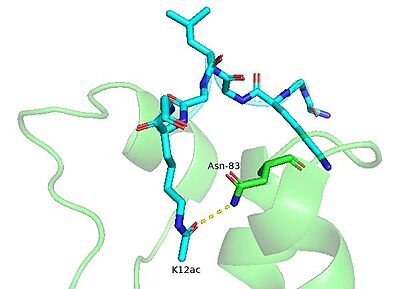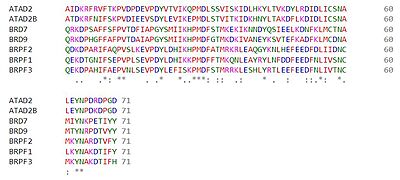User:Brian Boyle/Sandbox 1
From Proteopedia
| Line 13: | Line 13: | ||
[[Image:Kac N83 PyMOL Image.JPG | thumb | 400x400px | BRPF1 Asn-83 forms a hydrogen bond with the carbonyl moiety of the acetyllysine residue. The bromodomain is shown in green. The H4K12ac peptide is shown in cyan. (PDB entry 4QYD)]] | [[Image:Kac N83 PyMOL Image.JPG | thumb | 400x400px | BRPF1 Asn-83 forms a hydrogen bond with the carbonyl moiety of the acetyllysine residue. The bromodomain is shown in green. The H4K12ac peptide is shown in cyan. (PDB entry 4QYD)]] | ||
| - | The BRPF1 bromodomain has been shown to recognize and bind to various acetylated lysine marks on the N-terminal tails of histones tails <ref name="Glass1" />. It preferentially binds to histone H4 acetylated at positions K5 ([[2rs9]]), K8, and K12 ([[4qyd]]) as well as H3 and H2A (([[4qyl]]) at position K14 and K5, respectively<ref name="Obi" />,<ref name="Glass1" />. Interestingly, the BRPF1 bromodomain has also been shown to bind di-acetylated histone peptides with high affinity, including H4K5acK8ac and H4K5acK12ac <ref name="Obi" />. Acetyllysine recognition is coordinated by a number of residues in the bromodomain's binding pocket. Using NMR chemical shift perturbation experiments, Glass et al. reported several <scene name='91/910741/Nmr_resi_h4_binding/1'>key residues</scene> the undergo conformational changes upon histone H4 ligand binding (I27, L34, E36, V37, N83, and I88)<ref name="Obi" />. Notably, asparagine 83 was among these. The interaction between the amide nitrogen of asparagine with the carbonyl of the acetyllysine group is conserved in all bromodomains and is necessary for binding to occur <ref name ="Obi" />,<ref name ="Lubula_2014" />. Furthermore, the tyrosine 40 and isoleucine 27 stabilize the acetyllysine residue through water-mediated hydrogen bonds<ref name="Lubula_2014" />. | + | The BRPF1 bromodomain has been shown to recognize and bind to various acetylated lysine marks on the N-terminal tails of histones tails <ref name="Glass1" />. It preferentially binds to histone H4 acetylated at positions K5 ([[2rs9]]), K8, and K12 ([[4qyd]]) as well as H3 and H2A (([[4qyl]]) at position K14 and K5, respectively<ref name="Obi" />,<ref name="Glass1" />. Interestingly, the BRPF1 bromodomain has also been shown to bind di-acetylated histone peptides as a monomer with high affinity, including H4K5acK8ac and H4K5acK12ac <ref name="Obi" />. Acetyllysine recognition is coordinated by a number of residues in the bromodomain's binding pocket. Using NMR chemical shift perturbation experiments, Glass et al. reported several <scene name='91/910741/Nmr_resi_h4_binding/1'>key residues</scene> the undergo conformational changes upon histone H4 ligand binding (I27, L34, E36, V37, N83, and I88)<ref name="Obi" />. Notably, asparagine 83 was among these. The interaction between the amide nitrogen of asparagine with the carbonyl of the acetyllysine group is conserved in all bromodomains and is necessary for binding to occur <ref name ="Obi" />,<ref name ="Lubula_2014" />. Furthermore, the tyrosine 40 and isoleucine 27 stabilize the acetyllysine residue through water-mediated hydrogen bonds<ref name="Lubula_2014" />. |
== '''PWWP Domain''' == | == '''PWWP Domain''' == | ||
| Line 36: | Line 36: | ||
== '''Available Structures''' == | == '''Available Structures''' == | ||
The following are some, but not all, of the available structures containing domains of BRPF1: | The following are some, but not all, of the available structures containing domains of BRPF1: | ||
| + | |||
| + | Bromodomain (apo): [[2d92]] | ||
| + | Bromodomain w/ histone peptides: [[4qyl]], [[4qyd]], [[5ffv]], [[5ffw]] | ||
| + | Bromodomain w/ inhibitors: [[6ekq]], [[5ov8]], [[5o5h]], [[5o5f]], [[5o5a]], [[5o55]] | ||
| + | PZP (apo): [[5erc]] | ||
| + | PZP w/ histone H3 peptide: [[6u04]] | ||
| + | PWWP (apo): [[2x35]] | ||
| + | PWWP w/ H3K36me3: [[2x4w]], [[2x4y]], [[2x4x]] | ||
== '''References''' == | == '''References''' == | ||
<references/> | <references/> | ||
Current revision
| |||||||||||
Contents |
BRPF1 Association with the MOZ HAT Complex
The MOZ Histone Acetyltransferase Complex is a tetramer consisting of MEAF6, ING5, BRPF1 and MOZ or MORF[2]. Within BRPF1, there are two non-chromatin-binding modules surrounding the PZP domain that are responsible for its association with the MOZ HAT Complex. On the N-terminal side of the PZP, lies the MOZ/MORF binding domain[13]. On the other side of the PZP domain, there is a small module involved in binding to ING5 and MEAF6[14]. BRPF1 seems to be required for the formation of the MOZ HAT complex, as it acts as a bridge associating MOZ or MORF with ING5 and MEAF6[14].
Sequential and Structural Conservation in BRPF1
Bromodomains are categorized into several families based on sequence and structural similarity. The BRPF1 bromodomain belongs to family IV of bromodomains[15]. Out of these bromodomain proteins, the BRPF3 bromodomain has the highest sequence identity with that of BRPF1 (66.2%). A specific asparagine residue is conserved across all bromodomains due to its integral role in acetyllysine recognition.
PWWP domains have very low sequence and structural conservation. In fact, BRPF1 actually contains a PSYP motif rather than the canonical PWWP motif, however this change doesn't impact its ability to recognize methylated lysine. Furthermore, while many PWWP domains contain a β-barrel, there are significant differences in other structural aspects among PWWP domains[16]. The aromatic cage in the β-barrel is a conserved structure and is necessary for methyllysine binding[16].
Links to Human Disease
BRPF1 has been implicated in the progression of several cancers. Chromosomal translocations of the gene encoding MOZ (a subunit in the MOZ HAT complex) have been linked to the development of acute myeloid leukemia [4]. The crucial role of BRPF1 in this complex has made it the subject of many studies in order to understand how this mutation leads to cancer. Another study reported an association between upregulation of the BRPF1 gene and poor survival rates in hepatocellular carcinoma patients [17].
Mutations within the gene itself have been associated with neurological disorders and widespread reduced histone acetylation [1].
Available Structures
The following are some, but not all, of the available structures containing domains of BRPF1:
Bromodomain (apo): 2d92 Bromodomain w/ histone peptides: 4qyl, 4qyd, 5ffv, 5ffw Bromodomain w/ inhibitors: 6ekq, 5ov8, 5o5h, 5o5f, 5o5a, 5o55 PZP (apo): 5erc PZP w/ histone H3 peptide: 6u04 PWWP (apo): 2x35 PWWP w/ H3K36me3: 2x4w, 2x4y, 2x4x
References
- ↑ 1.0 1.1 Yan K, Rousseau J, Littlejohn RO, Kiss C, Lehman A, Rosenfeld JA, Stumpel CT, Stegmann AP, Robak L, Scaglia F, Nguyen TT, Fu H, Ajeawung NF, Camurri MV, Li L, Gardham A, Panis B, Almannai M, Sacoto MJ, Baskin B, Ruivenkamp C, Xia F, Bi W, Cho MT, Potjer TP, Santen GW, Parker MJ, Canham N, McKinnon M, Potocki L, MacKenzie JJ, Roeder ER, Campeau PM, Yang XJ. Mutations in the Chromatin Regulator Gene BRPF1 Cause Syndromic Intellectual Disability and Deficient Histone Acetylation. Am J Hum Genet. 2017 Jan 5;100(1):91-104. doi: 10.1016/j.ajhg.2016.11.011. Epub, 2016 Dec 8. PMID:27939640 doi:http://dx.doi.org/10.1016/j.ajhg.2016.11.011
- ↑ 2.0 2.1 2.2 2.3 2.4 2.5 Klein BJ, Cox KL, Jang SM, Cote J, Poirier MG, Kutateladze TG. Molecular Basis for the PZP Domain of BRPF1 Association with Chromatin. Structure. 2019 Nov 6. pii: S0969-2126(19)30355-7. doi:, 10.1016/j.str.2019.10.014. PMID:31711755 doi:http://dx.doi.org/10.1016/j.str.2019.10.014
- ↑ 3.0 3.1 3.2 Poplawski A, Hu K, Lee W, Natesan S, Peng D, Carlson S, Shi X, Balaz S, Markley JL, Glass KC. Molecular insights into the recognition of N-terminal histone modifications by the BRPF1 bromodomain. J Mol Biol. 2014 Apr 17;426(8):1661-76. doi: 10.1016/j.jmb.2013.12.007. Epub 2013, Dec 12. PMID:24333487 doi:http://dx.doi.org/10.1016/j.jmb.2013.12.007
- ↑ 4.0 4.1 4.2 4.3 4.4 4.5 Obi JO, Lubula MY, Cornilescu G, Henrickson A, McGuire K, Evans CM, Phillips M, Boyson SP, Demeler B, Markley JL, Glass KC. The BRPF1 bromodomain is a molecular reader of di-acetyllysine. Curr Res Struct Biol. 2020;2:104-115. doi: 10.1016/j.crstbi.2020.05.001. Epub, 2020 May 12. PMID:33554132 doi:http://dx.doi.org/10.1016/j.crstbi.2020.05.001
- ↑ Hibiya K, Katsumoto T, Kondo T, Kitabayashi I, Kudo A. Brpf1, a subunit of the MOZ histone acetyl transferase complex, maintains expression of anterior and posterior Hox genes for proper patterning of craniofacial and caudal skeletons. Dev Biol. 2009 May 15;329(2):176-90. doi: 10.1016/j.ydbio.2009.02.021. Epub 2009 , Feb 27. PMID:19254709 doi:http://dx.doi.org/10.1016/j.ydbio.2009.02.021
- ↑ You L, Li L, Zou J, Yan K, Belle J, Nijnik A, Wang E, Yang XJ. BRPF1 is essential for development of fetal hematopoietic stem cells. J Clin Invest. 2016 Sep 1;126(9):3247-62. doi: 10.1172/JCI80711. Epub 2016 Aug 8. PMID:27500495 doi:http://dx.doi.org/10.1172/JCI80711
- ↑ Klein BJ, Muthurajan UM, Lalonde ME, Gibson MD, Andrews FH, Hepler M, Machida S, Yan K, Kurumizaka H, Poirier MG, Cote J, Luger K, Kutateladze TG. Bivalent interaction of the PZP domain of BRPF1 with the nucleosome impacts chromatin dynamics and acetylation. Nucleic Acids Res. 2015 Nov 30. pii: gkv1321. PMID:26626149 doi:http://dx.doi.org/10.1093/nar/gkv1321
- ↑ 8.0 8.1 8.2 8.3 Lubula MY, Eckenroth BE, Carlson S, Poplawski A, Chruszcz M, Glass KC. Structural insights into recognition of acetylated histone ligands by the BRPF1 bromodomain. FEBS Lett. 2014 Sep 30. pii: S0014-5793(14)00705-4. doi:, 10.1016/j.febslet.2014.09.028. PMID:25281266 doi:http://dx.doi.org/10.1016/j.febslet.2014.09.028
- ↑ Qiu C, Sawada K, Zhang X, Cheng X. The PWWP domain of mammalian DNA methyltransferase Dnmt3b defines a new family of DNA-binding folds. Nat Struct Biol. 2002 Mar;9(3):217-24. PMID:11836534 doi:10.1038/nsb759
- ↑ Vezzoli A, Bonadies N, Allen MD, Freund SM, Santiveri CM, Kvinlaug BT, Huntly BJ, Gottgens B, Bycroft M. Molecular basis of histone H3K36me3 recognition by the PWWP domain of Brpf1. Nat Struct Mol Biol. 2010 May;17(5):617-9. Epub 2010 Apr 18. PMID:20400950 doi:10.1038/nsmb.1797
- ↑ Kolasinska-Zwierz P, Down T, Latorre I, Liu T, Liu XS, Ahringer J. Differential chromatin marking of introns and expressed exons by H3K36me3. Nat Genet. 2009 Mar;41(3):376-81. doi: 10.1038/ng.322. Epub 2009 Feb 1. PMID:19182803 doi:http://dx.doi.org/10.1038/ng.322
- ↑ Nimura K, Ura K, Shiratori H, Ikawa M, Okabe M, Schwartz RJ, Kaneda Y. A histone H3 lysine 36 trimethyltransferase links Nkx2-5 to Wolf-Hirschhorn syndrome. Nature. 2009 Jul 9;460(7252):287-91. doi: 10.1038/nature08086. Epub 2009 May 31. PMID:19483677 doi:http://dx.doi.org/10.1038/nature08086
- ↑ Lalonde ME, Avvakumov N, Glass KC, Joncas FH, Saksouk N, Holliday M, Paquet E, Yan K, Tong Q, Klein BJ, Tan S, Yang XJ, Kutateladze TG, Cote J. Exchange of associated factors directs a switch in HBO1 acetyltransferase histone tail specificity. Genes Dev. 2013 Sep 15;27(18):2009-24. doi: 10.1101/gad.223396.113. PMID:24065767 doi:http://dx.doi.org/10.1101/gad.223396.113
- ↑ 14.0 14.1 Ullah M, Pelletier N, Xiao L, Zhao SP, Wang K, Degerny C, Tahmasebi S, Cayrou C, Doyon Y, Goh SL, Champagne N, Cote J, Yang XJ. Molecular architecture of quartet MOZ/MORF histone acetyltransferase complexes. Mol Cell Biol. 2008 Nov;28(22):6828-43. doi: 10.1128/MCB.01297-08. Epub 2008 Sep , 15. PMID:18794358 doi:10.1128/MCB.01297-08
- ↑ Lloyd JT, Glass KC. Biological function and histone recognition of family IV bromodomain-containing proteins. J Cell Physiol. 2018 Mar;233(3):1877-1886. doi: 10.1002/jcp.26010. Epub 2017 Jun , 13. PMID:28500727 doi:http://dx.doi.org/10.1002/jcp.26010
- ↑ 16.0 16.1 Wu H, Zeng H, Lam R, Tempel W, Amaya MF, Xu C, Dombrovski L, Qiu W, Wang Y, Min J. Structural and Histone Binding Ability Characterizations of Human PWWP Domains. PLoS One. 2011;6(6):e18919. Epub 2011 Jun 20. PMID:21720545 doi:10.1371/journal.pone.0018919
- ↑ Cheng CL, Tsang FH, Wei L, Chen M, Chin DW, Shen J, Law CT, Lee D, Wong CC, Ng IO, Wong CM. Bromodomain-containing protein BRPF1 is a therapeutic target for liver cancer. Commun Biol. 2021 Jul 20;4(1):888. doi: 10.1038/s42003-021-02405-6. PMID:34285329 doi:http://dx.doi.org/10.1038/s42003-021-02405-6


